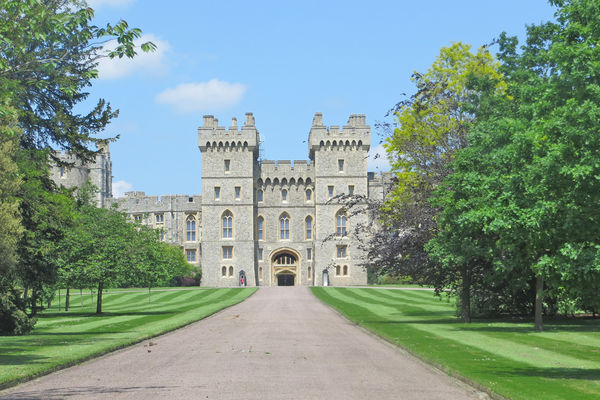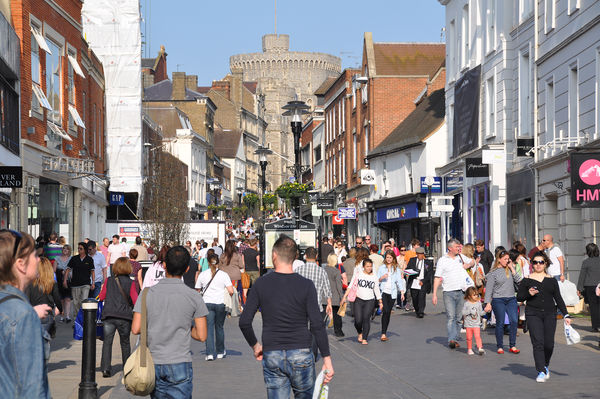The Queen Stays at Windsor — Why Not You?
By Rick Steves

British royalty has been calling Windsor Castle home since the days of William the Conqueror — almost a thousand years ago — and it was the favored castle of Queen Elizabeth. While commoners can't stay in Liz's former digs, the town that lies just outside its walls does make for a cozy stay. I find it to be an especially good spot for a peaceful and charming last night in England before flying out from London.
Even though it lies just under the landing path of planes coming into London's Heathrow Airport, Windsor is a delightful town at night — and its B&Bs are far less expensive than London's hotels. The town, which sits along the Thames River, has a wonderful pedestrian zone right in the shadow of the hulking castle, and an enticing array of small restaurants and pubs. Windsor also works as a day trip from London, only 20 miles away and accessible by train in under an hour.
Day or night, the castle dominates the town. William built the first fortification in the late 11th century for himself and his occupying Norman forces. Meant for defense more than comfort, it was basically just an earthen mound surrounded by a stockade with a lookout tower. Back then castles were crude, cold, damp, and dark, with little privacy. (I've stayed in youth hostels like that.) But with easy access to London and a handy hunting forest nearby, it was only a matter of time before later royals began enhancing the site as a sumptuous palace.
Nowadays, the castle's lavish state apartments are open whenever the queen isn't in residence (she flies her standard from the castle's Round Tower when she's home — usually on weekends). Dripping with chandeliers, finely furnished, and strewn with history and the art of a long line of kings and queens, these royal rooms are the best I've seen in Britain.
Pay a visit here and you'll see a grand vestibule decorated with exotic items seized by British troops as they colonized various corners of the world, plush rooms wallpapered with heroic portraits, and some of the finest works from the royal art collection.
The castle's spectacular (and huge) St. George's Hall is decorated with the colorful emblems of the knights of the chivalric Order of the Garter. For state banquets, the queen sets a single table stretching the length of the hall, seating 160 guests. (The cooks in the kitchen keep their clocks set five minutes fast to be sure that the queen's meal is never late.) You know you're important if you're invited for a "dine and sleep" — dinner followed by an overnight in the castle.
A visit to the lavish state rooms includes a chance to enjoy an up-close peek at Queen Mary's Dolls' House. Made for the current queen's grandmother in 1924, this miniature masterpiece is executed in astonishing detail. Each fork, knife, and spoon on the expertly set banquet table is made of real silver — and the tiny pipes of its plumbing system actually have running water.
The castle grounds are also home to St. George's Chapel, one of the finest examples of Gothic architecture in England. Dating from about 1500, it holds the tombs of 10 sovereigns, including Henry VIII and his favorite wife, Jane Seymour (favored perhaps because she was the only one who died before he could divorce or behead her).
During World War II, then-Princess Elizabeth and her sister Princess Margaret spent much of their time at Windsor, safely away from the bombing in London. The castle survived the war years unscathed, but 50 years later, on November 29, 1992, a catastrophic fire destroyed some of its finest spaces. It took 15 hours and 1.5 million gallons of water to put out the blaze — and five years and about $55 million to restore it.
The castle's not the only icon of British privilege on this spot. Across the Thames from Windsor, in the neighboring village of Eton, is the country's most famous private high school. Eton College has molded the characters of 19 prime ministers as well as members of the royal family (most recently Princes William and Harry).
Today this exclusive enclave educates about 1,300 boys (age 13–18). A guided tour gives visitors a glimpse of the schoolyard, chapel, cloisters, and a museum dedicated to "Eton life" (with artifacts that include the birch whips once used to discipline students).
Even if you're not touring the school, it's worth the few minutes it takes to wander up Eton's High Street for its mix of antique shops, boutiques, and restaurants. Architecture buffs will appreciate some finely preserved shop fronts with typical 15th-century timber-framing.
While 99 percent of visitors come to Windsor just to tour the castle and go, overnighters have the added pleasure of attending evensong in St. George's Chapel, with a glorious fan-vaulted ceiling overhead, Henry underfoot, and the banners of the knights of the Garter all around. Consider this as a royal sendoff for your last night in Great Britain.

